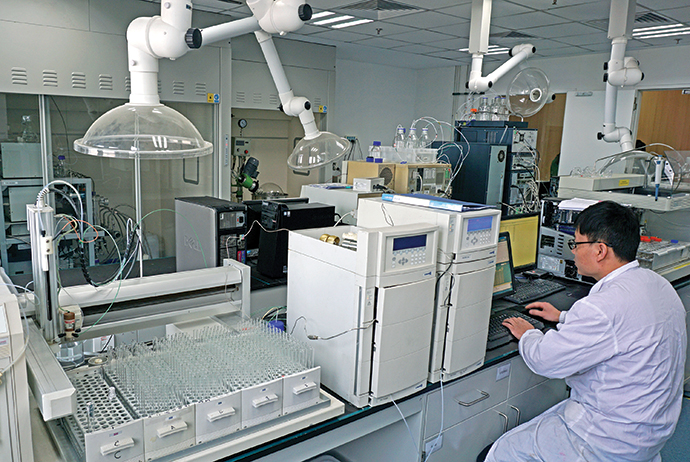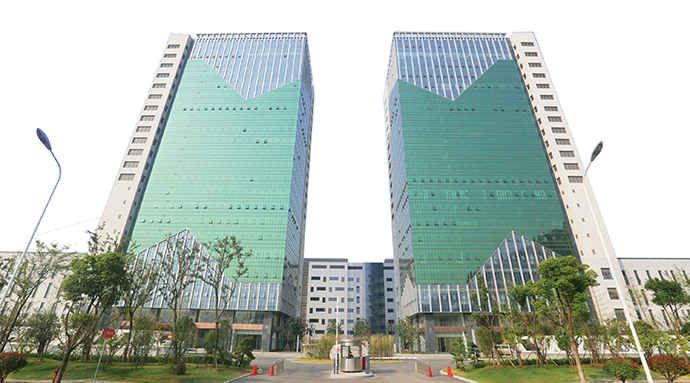You can tell which way Nanjing is expanding by the many new bridges, tunnels and metro lines being built across, or under, the Yangtse River, north of the ancient city’s central business district. All this infrastructure ends up in the Nanjing Jiangbei New Area, a district created by the State Council in 2015 to serve as a new growth engine for eastern China in the Yangtse Delta Zone. At nearly 800 square kilometers, or 308 square miles, the Nanjing Jiangbei New Area is home to several industrial parks, including the Nanjing Chemical Industrial Park, which is known as the chemical industry cradle of modern China.
It also is home to the Nanjing Biotech and Pharmaceutical Valley (NJBPV) with 15 square kilometers (5.8 square miles) of research and development and manufacturing space. It’s the heart of Gene City — a cluster of life sciences and healthcare companies, research facilities, hospitals and business-support services. Gene City is one of three “municipalities” in the New Area. Chip City, or Circuit City, is a similar cluster for the IT industry, with an emphasis on integrated circuits and high-end electronics. A Financial Center is home to banks and institutions that support startups and commercially viable innovation taking shape in the other two.
Gene City, with its pharmaceuticals and medical device specialties, is more than mere land. NJBPV makes it possible for companies to start work immediately, because everything from research space to labs to manufacturing space already is in place — investing companies don’t need to build their own until the day comes that they outgrow these facilities.
“We now have more than 400 companies here,” says Chen Hong, Director of the Nanjing Jiangbei New Area’s Life Science & Health Industry Office. “We have invested around US$15 million to purchase the clinical instruments for the research, including those for chemical analysis and biotech research. That is one of the public platforms we make available to investors. We also have a research arrangement with Nanjing University, which has a National Genetically Engineered Mice Resource Bank. It can provide these mice for the pharmaceutical companies’ research.”
One-Stop Biomedical Shop
Gene City intends to add value along “the complete industry chain in the life sciences and health industries, including medical services, high-end medical devices and big data,” says Hong. “We have five square kilometers [2 square miles] just for the international health center,” he adds. “This area will attract organizations that can provide medical services like hospitalization and rehabilitation, and training and education. We are cooperating with Cambridge University to build a research center here, and we collaborate with Uppsala University in Sweden to build medical organizations here. We also work with Beth Israel Deaconess Medical Center, a teaching hospital of Harvard Medical School, which is building a center here — this will be a high-end medical research center. We also connect with medical organizations in Europe that would build specialized hospitals here, such as for cardiology.”

Big data? Very big data. A DNA sequencing platform is being built in the Nanjing Jiangbei New Area, part of a genetic information database for ethnic Chinese. The project is part of the National Health & Medicine Big Data (Nanjing) Center, an $894 million center now under construction and slated for completion in 2021. Health and medical information on about 80 million people, the equivalent of the population in Jiangsu, will be stored at the center. The DNA sequencing project will be jointly undertaken by the state-owned Yangzi Group, Southeast University and Nanjing Medical University.
Researchers will use big data created in the database to study genetic mutations related to major diseases, look for the impact of interaction between genes and environmental concerns on human heath, and provide statistical support for diagnosis and treatment of major diseases, according to the provincial health and family planning commission. The program will focus on population genetics, newborns, childhood brain and cognitive development, cancer and rare and chronic diseases.
Location DNA
What do biotech investors think about Nanjing as a location for their businesses? They are in agreement on some key area attributes.
GenScript started operations in Nanjing in 2004, two years after the company was founded. Today, it employs more than 2,500. GenScript is a leading contract research organization providing gene, peptide, protein, CRISPR, and antibody reagents to scientists in over 100 countries worldwide. The company’s founder, Dr. Frank Zhang, taught at Nanjing University, so he was more than familiar with the city.
Beyond that, “Nanjing has some very obvious advantages,” says Celine Wang, Investment Negotiation Manager. “The many famous universities make ready-to-use talent available, and Nanjing is very convenient being so close to Shanghai. Most of our customers are international, so it is very easy for them to access us and for us to visit them. Also, we have very good government support.”
Geneseeq Technology picked a location in the Sino-Danish Science Park in NJBPV several years ago when the Toronto, Ontario-based genetic testing and research company needed a testing facility in the huge Chinese market. It’s turning out to be a perfect fit. The company helps determine the best oncology treatment for cancer patients based on their genetic makeup. Oncologists and hospitals are the company’s market, which eventually will extend to the patients themselves.
The bulk of Geneseeq’s R&D is done in Toronto, but the R&D must one day become applied. In 2013, it was decided by company management that China was the best market, given its vastly larger population than Canada and the U.S.
Why was Nanjing chosen over so many other Chinese location options?
“We were looking for areas with the best policies to support us,” says Marc Zhao, Chief Operating Officer. “What we cared about most at the time was first, if the government or the New Area have specific support for your specific company. One company, one policy. That is very attractive, and they did that. The support is all customized. We went to more than 20 cities in China before coming back to Nanjing. We took the decision very seriously, did a lot of cross checking and comparisons and eventually picked the Nanjing Jiangbei New Area as the location for our Chinese headquarters.”
The second consideration was talent, Zhao relates.
“Life sciences are highly technical and highly skilled, so you must make sure there is enough of that talent to support the business,” he says. “If you rank Chinese cities in life sciences, Nanjing would be in the top three because of the strong university support.” It’s home to more than 50 colleges and universities, 75 research institutes, 17 national engineering technology centers and 25 national key laboratories. “The universities in Nanjing are very strong in the biomedical and life sciences areas,” Zhao points out. Geneseeq employs more than 400 in Nanjing, approximately 70% of which are local graduates.


A third factor in Nanjing’s favor at the time of the headquarters search was the location of the city, in the Yangtse River area.
“The high-speed railway makes it possible for me to travel to most of the cities I want to visit — Shanghai and all of Jiangsu province, up to Beijing and west to Wuhan,” says Zhao. “Nanjing is very strategically located. It is very convenient. If I need to go to Guangzhou in the southeast or to northeast China, I can fly from Nanjing. The location is very good.”
A fourth factor was cost management, says Zhao.
“The living costs, the compensation levels in Nanjing are Tier 2 compared to Beijing and Shanghai, the latter being very close to Nanjing,” says Zhao. “It’s just 90 minutes by high-speed rail. Wages are roughly 30% higher in Shanghai than in Nanjing. There are cheaper cities in China than Nanjing,” Zhao adds, “but you have to balance the factors I have listed — the policies, talents, physical location and cost management. We made the decision that Nanjing is the best location for our company.
Better Than Before
“That was six years ago,” he says. “If we look back now, do we have any regrets? Is there a better location choice for our company? No. The four factors I talked about still exist, and their merits are even stronger over the last five years. We have even more support from the central government, and companies coming here now looking at the policy component will find even better terms than we did.”
The location is better than six years ago, because the trains are even faster, notes Zhao, and connectivity has improved. The universities continue to deliver a strong talent base, and the cost benefit of Nanjing has increased. “Real estate prices in Shanghai and Beijing have risen dramatically more than in Nanjing in the past five years,” says Zhao. “Everything is better than five years ago.”
Since the establishment of the Nanjing headquarters, Zhao has added another factor that makes the city the right location: “We are the icon of genetic testing in China,” he explains. “Like a magnet, we are attracting more people to come work at the company. In Shanghai, you always have competitors. In Nanjing, anyone who wants to get into this business thinks first of Geneseeq. There are advantages to being the best in the industry,” he says, not the least of which are finding business partners easily and having the pick of the brightest candidates for employment. “These advantages are amplified, which is a key message,” says Zhao. “Being able to take advantage of these factors over the last several years in Nanjing makes my decision to base our operations here one of the best decisions I have made in my entire career.”
This Investment Profile was prepared under the auspices of the Nanjing Municipal Bureau of Commerce. For information, visit www.investnanjing.gov.cn.

